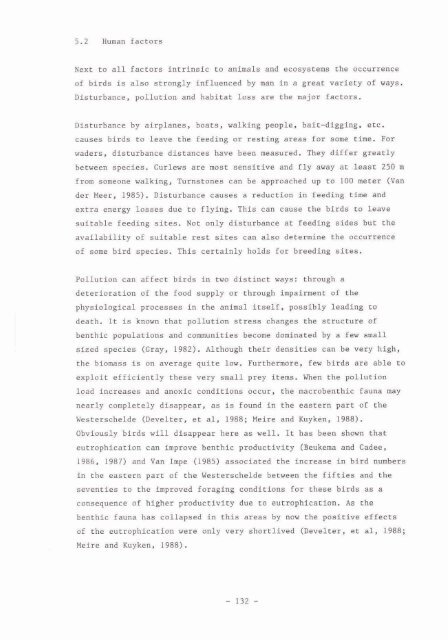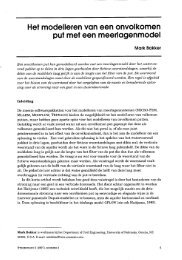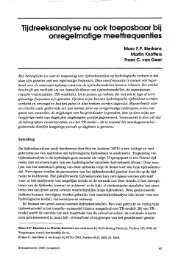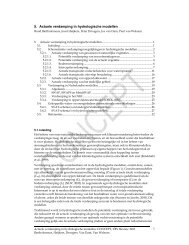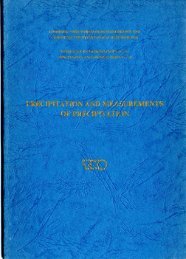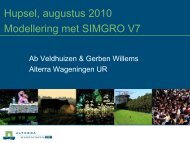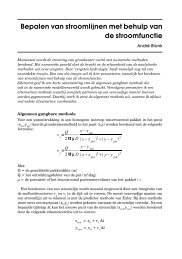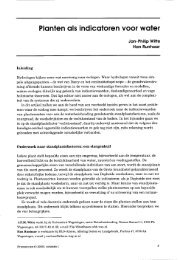Hydro-ecological relations in the Delta Waters
Hydro-ecological relations in the Delta Waters
Hydro-ecological relations in the Delta Waters
You also want an ePaper? Increase the reach of your titles
YUMPU automatically turns print PDFs into web optimized ePapers that Google loves.
5.2 H- factors<br />
Next to all fartors <strong>in</strong>tr<strong>in</strong>sic to animals and ecosystem.? <strong>the</strong> occurrence<br />
of htrds is also strongly <strong>in</strong>fluenced by man <strong>in</strong> a great variety of ways.<br />
Disturbance, pellution and habitat loss are <strong>the</strong> major factors.<br />
Disturbance by airplanea. beats, walk<strong>in</strong>g people, bait-diggiw. etc.<br />
causes bitds to leave <strong>the</strong> feed<strong>in</strong>g ar rerrf<strong>in</strong>g areas fot some time, For<br />
waders, disturbance distances have been measured. They differ greatly<br />
between species. Curlews are most sensitive and fly away at leaat 250 m<br />
from someone walk<strong>in</strong>g, Turnstones can be approacbad up to 1130 meter (Van<br />
der &er. 1985). Disturbance causes a reduction <strong>in</strong> feed<strong>in</strong>g time and<br />
extra energy losses due to fly<strong>in</strong>g. This can cause <strong>the</strong> birds to leave<br />
suitable feed<strong>in</strong>g sites. Not only disturbance at feed<strong>in</strong>g sides but <strong>the</strong><br />
availability of suitable rest sites can alss determ<strong>in</strong>e <strong>the</strong> occurrence<br />
of some bird species. Thia certa<strong>in</strong>ly holds for breed<strong>in</strong>g sites.<br />
Pollution cab affect birds <strong>in</strong> tws dist<strong>in</strong>ct ways: rbrougb a<br />
deteriozation of <strong>the</strong> food supply or through impairment of <strong>the</strong><br />
physiological processes <strong>in</strong> <strong>the</strong> animal itself. possibly lead<strong>in</strong>g CO<br />
death. It is known that pollution sees chaagea <strong>the</strong> structure of<br />
benthic populations a& cmmamities become dam<strong>in</strong>ated by a few small<br />
sized $peCies (Oxay, 1982). Although <strong>the</strong>ir densities can be very high.<br />
<strong>the</strong> biomss is on average quite low. Bur<strong>the</strong>rmore, few birds are able to<br />
exploit efficient13 thme very small prey items. When <strong>the</strong> pollutfon<br />
load <strong>in</strong>creases and anoxic conditions oceur, <strong>the</strong> macrobenthic faona may<br />
nearly completely dieappear, as is found <strong>in</strong> <strong>the</strong> eastern patt of <strong>the</strong><br />
Westerschelde CDevelter, et al. 1988; Meire and Kuyken, 1988).<br />
Obviously birds will disappear here as well. It has been &own that<br />
eutmphtcetion can improve benthic productivity (Bewkema and Cadee,<br />
1986, 1987) and Van Impe (1985) associated <strong>the</strong> <strong>in</strong>crease <strong>in</strong> bird numbets<br />
In <strong>the</strong> eastern part of <strong>the</strong> Westersehelde between <strong>the</strong> fifeies and <strong>the</strong><br />
seventies to <strong>the</strong> improved ferag<strong>in</strong>g couditiells for <strong>the</strong>-e birds as a<br />
eonsequenee of hlgher preductivity due to eutropwcation. As <strong>the</strong><br />
benthix fauna has collapsed <strong>in</strong> this areas by now <strong>the</strong> posititre effects<br />
of <strong>the</strong> wtrophication were only very shartlived (Develter, et al. 1988;<br />
Meire and Kuyhn, 1988).


